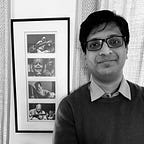Rama reclaims his throne from false avatars
A selection of Muthuswami Dikshitar’s compositions on Saketa Rama
I marked the 2019 Lok Sabha election results with a blogpost. It was a despairing post at a time when my faith in constitutional processes was at a low. I despaired in particular at the grotesque twisting of the Hindu mind by malignant Hindutva. I took solace in the compositions of Thyagaraja on Rama, in the raga Kharaharapriya. The themes of those compositions were myriad, but the abiding message was that of the gentleness of Rama and the straightforward, personal nature of faith in him.
I am happy to admit that I was wrong to have such little faith in the electoral process. But I was right in thinking that the combination of incompetence and hubris would bring down the Hindutva regime. This has come to pass not wholly or in full measure — but very substantially.
And indeed, hubris has had a role to play. Nothing epitomized the rank hubris of this regime like its totemic head declaring himself abiological, a celestial being descended from the heavens, sent by the gods. [All the signs were there always, for those who cared to see…it is galling that he always referred to himself in the third person, like a vaudeville Bollywood villain might]. And no contest was more symbolic of the great chastisement as the BJP losing the Faizabad / Ayodhya constituency (while Faizabad district was unthinkingly renamed Ayodhya district, the constituency remains Faizabad). It would seem that the people of Ayodhya have reclaimed the throne from false avatars, for their beloved Rama.
To mark the occasion, here is a selection of three songs by Muthuswami Dikshitar, in which he describes Rama as Rama of Ayodhya.
Ramachandram Bhavayami, Vasantha Raga
This is one of my favourite songs. Dikshitar describes Rama as Saketa Nagare Nivasasantham — Saketa Nagara being Ayodhya. This is also the phrase in which he ensconces the raga mudra — you can find the raga’s name (Vasantha) in the phrase. Here is an excellent rendition by Dr. S Sowmya, preceded by an alapana.
Santana Ramaswaminam, Hindolavasantham Raga
In this piece, Dikshitar uses the phrase / name Yamunambapuri for Ayodhya, describing Rama as a resident (nivasantham) of the place. A small example of Dikshitar’s lyrical mastery — a fun thought exercise would be to replace “Yamunambapuri” with “Saketa Nagara” or “Ayodhya” and observe how that might affect the musicality and poetry of the composition.
Here is a rendition by TM Krishna, followed by swara-kalpana improvisation, replete with ‘jantai-swaras’ or ‘joint notes’ (e.g. ma-ma ga-ga ma).
Ramakrishnena Samrakshitoham, Sahana Raga
And finally, a lovely little piece in Sahana that I am not familiar with, and which I found hard to come by online. The delightful conceit of the composition is its simultaneous treatment of two avatars of Vishnu — Rama and Krishna. Lyrics below sourced from Todd McComb’s page.
Pallavi: rAmakRSNEna samrakSitOham rAmAyaNabhAgavatapriyENa
Anupallavi: umApati vANIpati mahitEna kausalyA yashOdA bAlEna
Charanam: ayOdhyA dvArakA susadanEna amarEsha guruguhAdi viditEna jayasItAlakSmI mOhitEna jananAdi muktipradacaraNEna mAyAmArIca kamsahatEna mAnita vibhISaNAkrUrENa payOnidhicandrENa bharata balarAmasOdarENa prakaTa kIrtanEna
So you have:
Rama-Krishna (ena);
Ramayana-Bhagavata (priyena);
Kausalya-Yashoda (balena);
Ayodhya-Dvaraka (susadena);
MayaMaricha-Kamsa (hatena);
Bharata-Balarama (sodarena).
With the added bonus of Umapati-Vanipati to describle Shiva and Brahma!
Here is a rendition by the Serugudi Sisters.
